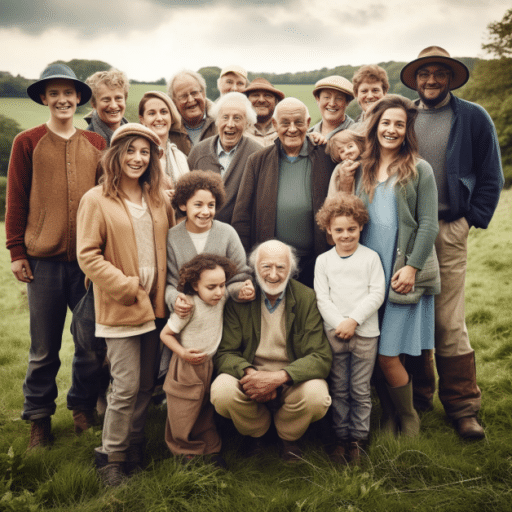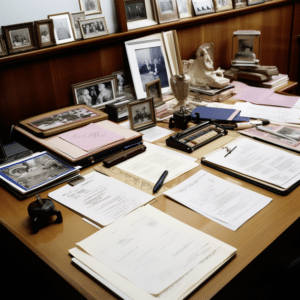The UK ancestry visa is a critical pathway for individuals with a UK grandparent to live and work in the United Kingdom. By helping you understand the requirements and navigate the process, this guide aims to simplify your journey toward securing your UK ancestry visa.
If you want to invest as an expat or high-net-worth individual, you can email me (hello@adamfayed.com) or use these contact options.
This article is mainly for people living outside the UK.
Step 1: Confirming Your Eligibility for a UK Ancestry Visa
Securing your UK ancestry visa is not an overnight journey. It involves careful scrutiny of eligibility criteria, understanding the requirements, and diligent preparation. Let’s unpack the first step of this process, which centers on confirming your eligibility for the UK ancestry visa. Remember, the key to a successful visa application lies in being clear about whether you qualify in the first place.

Understanding Ancestry Requirements
To apply for a UK ancestry visa, your lineage is your ticket. You need to confirm your direct descent from a UK-born grandparent. This means, whether, through your mother’s or father’s side, you should be able to trace your roots back to a grandparent born in the UK, including the Isle of Man and the Channel Islands. Make sure you gather all relevant documentation that attests to this relationship. This might include your birth certificate, your parent’s birth certificate, and your grandparent’s birth certificate.
Importantly, the UK ancestry visa doesn’t disregard the complexities of modern families. Therefore, if you’re adopted or part of a stepfamily, don’t let this deter you. You still qualify as long as you meet the specific conditions. For instance, if you’re adopted, the UK considers your adoptive grandparent your real grandparent for the UK ancestry visa.
Examining Citizenship and Age Requirements
After confirming your ancestry, it’s time to review your citizenship status. The UK ancestry visa is a privilege extended to citizens of Commonwealth countries. If you hold citizenship in 54 Commonwealth countries, you are one step closer to your UK ancestry visa.
Furthermore, age is a factor in your eligibility. You must be 17 years or older to apply for a UK ancestry visa. This requirement ensures that the visa applicants are, in most cases, legally adults capable of working.
And that brings us to the final piece of the eligibility puzzle – your intention and ability to work in the UK. This requirement is not just about filling job vacancies. It’s also a matter of ensuring you can sustain yourself financially while living in the UK.
You need to show that you plan to work and, in fact, are capable of working in the UK. This can be through a job offer, evidence of active job searches, or showcasing skills and qualifications relevant to the UK job market.
Step 2: Gathering Required Documents
Applying for your UK ancestry visa involves providing various documents that solidify your eligibility and ensure a smooth application process. These documents serve as the backbone of your application. Now, let’s delve into what documents you must collect and why each is crucial.
Preparing Personal Identification Documents
One of the foundational steps for your UK ancestry visa application is collecting your personal identification documents. A valid passport forms the basis of these documents. Ensure your passport is valid for your intended stay in the UK.
In addition, you’ll also need your birth certificate. This document verifies your age and your parents’ identity, thus further proving your eligibility for the UK ancestry visa. Always remember to use an official copy and, if necessary, provide certified translations for any documents not originally in English.
Proving Your Ancestry
Substantiating your claim of UK ancestry is essential in applying for a UK ancestry visa. Gathering the necessary documentation to demonstrate this can be an involved process, requiring careful attention to detail.
Primarily, you’ll need to provide your grandparent’s original birth certificates. If applicable, you’ll also need your parents’ marriage certificates. These documents establish the lineage from your UK-born grandparents to you, thereby validating your eligibility for the UK ancestry visa.
Remember to check the specific details required in these documents. For instance, your grandparent’s birth certificate should clearly show that they were born in the UK or were UK citizens at the time of your parent’s birth if they were serving in the UK forces.
Proof of Employment or Job Offer in the UK
Securing a UK ancestry visa requires you to demonstrate your ability and intention to work in the UK. This proof can be a job offer from a UK employer or evidence of current employment in the UK.
When providing proof of employment or a job offer, ensure the document includes the employer’s name and address, your role, salary, and contract length. The job you intend to undertake should not contradict the conditions set out on the UK ancestry visa.
Displaying Financial Self-Sufficiency
Lastly, you must provide proof of your financial self-sufficiency to complete your UK ancestry visa application. This evidence demonstrates that you can adequately support yourself and any dependents without accessing public funds.
The exact proof required can vary, but it generally includes bank statements, payslips, or a letter from a financial sponsor. These documents should reflect a stable and sufficient income or savings to support your living expenses in the UK.
Step 3: Completing the Visa Application
Securing your UK ancestry visa is a detailed process that becomes straightforward with careful preparation. A key part of this process is accurately completing the visa application. The application serves as the UK government’s first impression of you and your eligibility for the UK ancestry visa. Let’s delve into this process.
Navigating the Online Application Process
The digital age allows you to apply for your UK ancestry visa online, easing the process considerably. You will find the application on the official UK government website, specifically designed to streamline the application process and make it more accessible for all applicants.
When filling out the form, provide accurate details about your circumstances. This accuracy extends to your UK ancestry details as well. This section often involves filling in the dates and places of birth of your UK-born grandparents and your parents connected by direct lineage.
Documentation plays a crucial role in your UK ancestry visa application. You’ll need to upload all your documents, ensuring they are clear and easy to read. These may include birth certificates, marriage certificates, valid passports, proof of employment or a job offer in the UK, and evidence of financial self-sufficiency. Remember to double-check each upload for clarity and correctness, as errors can lead to delays or denial of your UK ancestry visa application.

Addressing Application Fees and Payment Methods
You must pay the application fee to complete your UK ancestry visa application. The fee for a UK ancestry visa stands at £516. However, confirming the current fee on the official UK government website is crucial since these figures can change over time.
Payment of this fee is part of the application process. You can make this payment using the various methods provided on the platform, such as a debit or credit card.
Furthermore, remember that your UK ancestry visa application is not considered complete until the payment of the application fee is successful. Always ensure the payment goes through to avoid unnecessary delays in your UK ancestry visa application process.
You can submit your UK ancestry visa application after you have accurately filled out the form, uploaded the necessary documents, and paid the fee. Patience becomes vital at this point, as getting feedback on your application may take a few weeks. Keep an eye on your provided email for any updates on your UK ancestry visa application.
Step 4: Scheduling and Attending a Biometric Appointment
As you progress in your UK ancestry visa application process, you reach a pivotal step: the biometric appointment. This mandatory requirement forms a key part of the UK Home Office’s identity verification process. In this section, we’ll explore the purpose of this appointment, how you can prepare for it, and what happens afterward.
Understanding the Purpose of the Biometric Appointment
The UK Home Office requires all UK ancestry visa applicants to undergo a biometric appointment. This appointment serves two primary purposes.
First, this appointment allows the authorities to collect your biometric data. Specifically, they’ll capture your fingerprints and photograph your face digitally. This data is unique to you and aids in your identification throughout your stay in the UK under the UK ancestry visa.
The second purpose is the creation of your Biometric Residence Permit (BRP). The BRP is an essential document that confirms your identity, visa status, and right to live, work, or study in the UK. The data collected at the biometric appointment is used to create this document.

Preparing for the Biometric Appointment
With a clear understanding of why the biometric appointment is essential for your UK ancestry visa application, you must know how to prepare for this significant event.
To start, gather the necessary documents. This typically includes your appointment confirmation, UK ancestry visa application form, and current passport. Check the requirements specified by the visa application center where you’ll have your appointment, as additional documents may be required.
Next, ensure you arrive on time. Late arrivals may result in your appointment being rescheduled, causing delays in your UK ancestry visa application process.
During the appointment, trained staff will guide you through the biometric data collection process. It’s straightforward and quick, often taking less than fifteen minutes. They’ll capture your fingerprints, photograph your face, and potentially confirm some personal details.
Once you’ve completed your biometric appointment, you’ll receive a stamp on your appointment confirmation document. This document is an essential part of your UK ancestry visa application. Keep it safe; you’ll need to submit it along with your other documents.
Step 5: Wait for the Decision
Securing your UK ancestry visa involves a waiting period after submitting your application. The anticipation might be stressful, but understanding the timeline for decision-making and the potential outcomes can provide some peace of mind.
Assessing the Timeline for the Visa Decision
Once you’ve submitted your UK ancestry visa application, a waiting period begins. According to the UK Government, the standard processing time for a UK ancestry visa is generally three weeks. This timeline starts from the date you submitted your application.
However, keep in mind that this timeline is not absolute. Several factors can influence the processing time of your UK ancestry visa application. For instance, the number of applications the UK immigration authorities receive at a given time can affect the processing speed. Holiday periods or unforeseen circumstances, such as a global pandemic, can also introduce delays.
While waiting for your UK ancestry visa, monitoring your application status regularly is important. The UK government provides online services for checking the status of your visa application.
If you notice a significant delay beyond the typical three-week period, you should contact the UK visa and immigration department for further clarification. Being proactive and staying informed can alleviate any anxiety you might experience during this waiting period.
Understanding Possible Outcomes and Next Steps
Upon the authorities’ approval of your UK ancestry visa application, they will inform you via the contact information you provided. This approval means you’ve successfully passed all requirements and can plan your journey to the UK. However, before booking your flight, ensure you have reviewed all the conditions attached to your visa. It’s also important to note the visa validity dates, as your visa is only valid within the specified period.
Unfortunately, not all UK ancestry visa applications get approved. If the authorities deny your application, they will explain the refusal. This feedback is valuable as it lets you understand where your application fell short and how to improve it for a potential reapplication or appeal.
In the event of a refusal, you have the right to appeal the decision, but this depends on the grounds provided in your refusal letter. It’s advisable to consult with an immigration lawyer to understand your options and the best way forward. Remember, denial doesn’t mean the end of your UK ancestry visa journey. With careful reconsideration and possibly expert advice, you could strengthen your application for future success.
Step 6: Arrival in the UK
Taking a flight to the UK after successfully securing your UK ancestry visa marks the beginning of a new and exciting chapter in your life. However, you must take certain steps upon arrival to ensure a smooth transition. You need to consider your Biometric Residence Permit (BRP) collection, potential police registration, and employment considerations as you settle into life as a UK ancestry visa holder.
Planning First Steps Upon Arrival
Once you set foot in the UK with your ancestry visa, you first need to check where to collect your Biometric Residence Permit (BRP). The BRP acts as your visa evidence, showing your rights and conditions of stay in the UK. Your decision letter will instruct you on where to collect it. Usually, you collect it within ten days of arrival unless you inform the Home Office that you will arrive later.
Another crucial step, if applicable, is registering with the police. Not all UK ancestry visa holders need to do this. However, if your visa decision letter states that you must register, ensure you do so within seven days of arrival in the UK. To register, you need to visit a designated police station and provide information about yourself and where you will be living.
Starting Work or Job Hunting in the UK
The essence of the UK ancestry visa lies in your intent and ability to work. Therefore, securing employment forms a crucial part of your settlement process. If you already have a job offer or transfer lined up, you should begin your employment promptly upon arrival. Starting your job allows you to earn an income and helps substantiate your fulfillment of the UK ancestry visa conditions.
The job hunt begins for those who arrived in the UK without a prearranged job. Remember, you can work in almost any job on a UK ancestry visa, giving you a broad employment scope. Take advantage of the numerous job search platforms and career services available to find a role that suits your skills and interests. As a UK ancestry visa holder, you can switch jobs without notifying the Home Office, provided you continue working.
Step 7: Maintaining Your Visa Status and Planning for the Future
In your journey with a UK ancestry visa, the final and perhaps the most critical step doesn’t have a definite end. This stage encompasses both the maintenance of your current visa status and the strategic planning for your long-term future in the UK. To navigate this stage effectively, you need a comprehensive understanding of your visa conditions and a clear vision for your future path toward permanent residency or citizenship.
Understanding Conditions of the UK Ancestry Visa
Securing your UK ancestry visa marks a significant milestone in your journey, but it’s only the beginning. To maintain your visa, you need to abide by certain conditions diligently.
One of the primary conditions of your UK ancestry visa is to remain gainfully employed. The UK government stipulates that you must work during your stay in the UK, reinforcing that this visa category is for those who contribute to the UK economy.
Whether self-employed or working for a UK employer, maintaining your employment status is essential to your eligibility. Keep records of your employment contracts and income as proof of your employment status.

Another crucial condition of the UK ancestry visa is financial independence. Your ability to support yourself and your dependents without relying on public funds is vital.
The definition of public funds includes a range of benefits, from income support to housing benefits. Regularly review your financial status and avoid circumstances that could make you reliant on public aid.
Planning for Indefinite Leave to Remain (ILR) and British Citizenship
After spending a significant period in the UK with your ancestry visa, you might consider taking the next step in your immigration journey – obtaining Indefinite Leave to Remain (ILR) or British Citizenship. These options offer more stability and freedom, making them appealing for long-term goals.
Typically, after five years of continuous residence in the UK under a UK ancestry visa, you may be eligible to apply for ILR. This status grants you the right to live in the UK without any time restrictions. Subsequently, after one year of holding ILR and six years of living in the UK, you may qualify to apply for British Citizenship.
However, there are additional requirements you’ll need to meet for both, including passing the “Life in the UK” test and meeting the English language requirements.
To apply for ILR or British Citizenship, prepare for an application process similar to your UK ancestry visa. You’ll need to provide a variety of documents, including proof of continuous residence and financial independence. You’ll also need to demonstrate your knowledge of life in the UK and proficiency in the English language.
Remember, as you transition from your UK ancestry visa to ILR and possibly British citizenship, each step requires careful planning, diligent preparation, and compliance with all immigration rules. The journey may be complex, but with the right guidance, it’s a worthwhile endeavor toward your dream of living permanently in the UK.
Pained by financial indecision?

Adam is an internationally recognised author on financial matters with over 830million answer views on Quora, a widely sold book on Amazon, and a contributor on Forbes.




I need visa I have all documents for my job